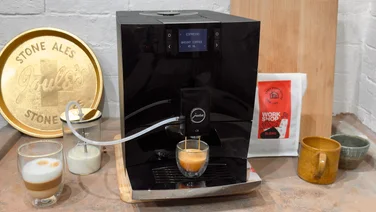To help us provide you with free impartial advice, we may earn a commission if you buy through links on our site. Learn more










I have to come straight out and say that the original Gaggia Classic was one of my all-time favourite espresso machines. From its industrial looks to the way that it simply made great coffee, it was a total winner. Times change and the old Classic simply couldn’t be sold anymore as it no longer met with EU law, so there’s a new Gaggia Classic coffee machine here to replace it.
Build quality
In some ways, I think that the choice of name is rather poor, as it invites comparisons between the old and the new. While the old machine was big, tough and all of the components felt professional, the new Classic suffers in comparison. Gone are the rocker switches on the front, replaced with a couple of slightly spongy feeling push-in buttons instead. The design change is because it makes it easier for power management to meet EU law. That I can live with.










The changes to the group handle and filter basket are harder to cope with. With the old Classic, Gaggia used its professional group handle, which is all metal. The new Classic has plastic spouts. It also has to be used with a plug-in plastic flow regulator, which helps create better crema but removes the pro feeling from the machine.










On this basis, anyone that owned the original Classic will be unimpressed with the new one. So, that’s it, right? Well, it’s not quite that easy, because I think it’s the name that causes problems for many people. So, don’t think of this as a replacement for the old Classic, but rather as a new manual machine designed to hit both the right price point and EU law. It’s under those conditions that I’ll review this model.
Making coffee
Gaggia provides two filter baskets for the group handle: one for a single espresso and one for a double. Make sure that you get the right one for the amount of coffee that you want to use, otherwise, you’ll get sub-standard results. You also need to ensure that you’ve inserted the flow regulator into the bottom of the group handle; fail to do this and when you pour a coffee, you’ll get spluttering hot espresso firing out of the spout and a frothy mess in your cup. You may want to warm your cup first, using the cup warmer on top of the machine.










With the right filter holder and the flow regulator in place, I got much better results, with a shot of espresso taking around 20 seconds to pour. It was a decent looking shot, too, with dark coffee and thick and rich-looking crema. If I’m being a little critical, I’d say that the crema was a little foamy, which is something I’ve noticed with other machines that use a flow regulator.










Temperature, at 68C, was very good and just about perfect for a shot of espresso. Thankfully, the taste was there, with the espresso tasting rich and strong, although missing a little bit of the subtlety that I find with more expensive manual models. Longer drinks should be possible, with the Classic giving you 85mm of clearance underneath to fit larger mugs.
Milk drinks
To make milk-based drinks, you first have to warm the machine up to steam temperature by pressing the button on the front. This takes less than a minute to do, so it won’t get in the way of making a coffee. Once you’re at temperature, the tap on the side of the machine lets you control the flow of steam through the wand. Again, build quality has changed from the original Classic and the tap feels a little cheap; however, its redesign means that you should no longer suffer from the Classic’s big problem: water leaking out of the steam wand. Getting milk up to temperature turned out to be easy and I soon had a jug of frothy milk to make a cappuccino or latte with. As with previous Gaggia machines, if you turn on the pump while the steam button is deployed, you can use the steamer wand to dispense hot water to top your drinks up with.










Getting milk up to temperature turned out to be easy and I soon had a jug of frothy milk to make a cappuccino or latte with. As with previous Gaggia machines, if you turn on the pump while the steam button is deployed, you can use the steamer wand to dispense hot water to top your drinks up with. Once finished with steam, the Classic doesn’t vent automatically and remains too hot to make coffee: before you pour another espresso it’s vital that you turn on the pump until water, rather than steam, starts to flow.
Maintenance
Manual machines are exceptionally easy to look after and the new Classic is no exception. I recommend pushing a shot of steam out of the wand after use, to prevent milk clogging it up, and the shower head should be wiped down regularly, while the drip tray needs a regular clean in soapy water. Aside from that, you should only have to descale the machine at regular intervals, following the simple instructions in the manual.
Conclusion
I have to say that the new Classic isn’t a patch on the old one: it’s more cheaply made and lacks the professional group handle. As such, anyone that had an original Classic won’t be impressed with this new machine. But, what about those people not familiar with the original Classic? Well, it’s still very much a mixed bag and the build quality isn’t great. That aside, the new Classic does make a decent shot of espresso and a milk drink, but the price is a little high. The truth is that you can spend a little more to buy a bean-to-cup machine, such as the Gaggia Naviglio, or less to buy the better-made manual Delonghi Scultura coffee machine. Those looking for an even better manual machine should read my best coffee machines article for my latest recommended choices.
| Specs | |
|---|---|
| Dimensions (HxWxD) | 380x230x240mm |
| Maximum mug height | 85mm |
| Water capacity | 2.1L |
| Pump pressure | 15bar |
| Cup warmer | Yes |
| Milk frothing | Yes (steamer wand) |
| Number of boilers | One |
| Coffee type | Ground coffee |







